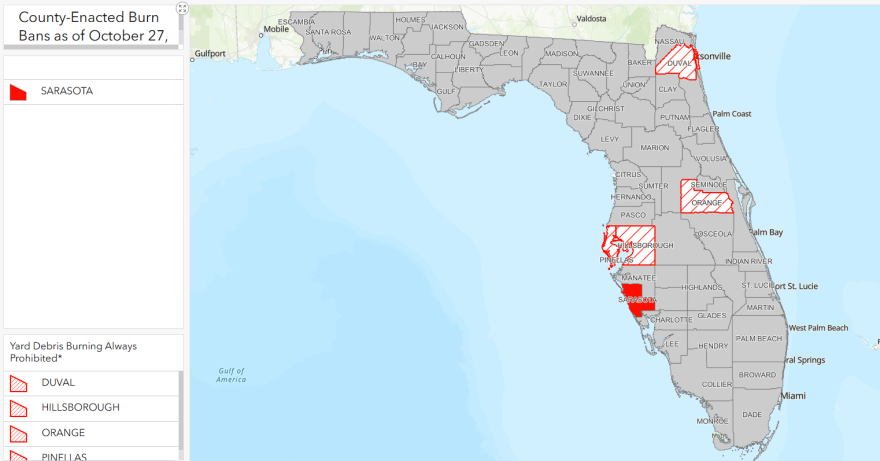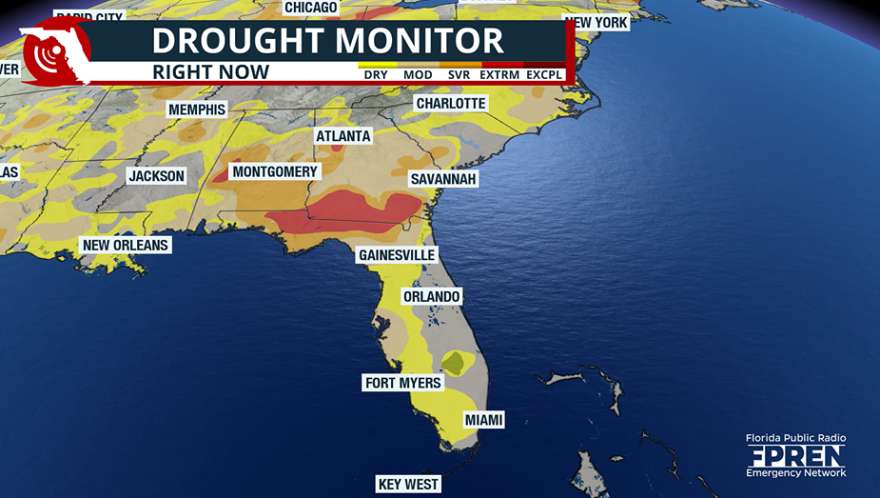Several Florida counties are now under burn bans in an effort to reduce the threat of wildfires, as more 70% of the state is considered to be unusually dry.
Sarasota and Manatee counties are the latest to enact burn bans, joining at least four other jurisdictions that have active restrictions.
While regulations vary by location, most burn bans prohibit campfires, yard debris fires and fireworks.
Officials say the goal is to prevent human-caused blazes from quickly spreading in the dry and sometimes breezy conditions.
“It’s been a very dry season,” Manatee County Public Safety Director Jodie Fiske said in a statement. “Our Emergency Management Division regularly talks with our Fire Chiefs Association and Forestry, and they are all in agreement that we need to enact a burn ban.”
Although Florida’s Gulf Coast has seen its share of a lack of rainfall, the most significant drought conditions are concentrated farther north along the Interstate 10 corridor.
The U.S. Drought Monitor has classified parts of the eastern Panhandle as being in a “extreme drought," with Calhoun County currently ranking as the driest in the state.
By contrast, Seminole County in Central Florida has reported seeing beneficial rainfall totals and remains among the wettest counties across the state.

The Florida Forest Service monitors drought and fire conditions daily across all 67 counties and adjusts its operations accordingly to what local weather conditions produce.
The agency notes that prolonged dry conditions can complicate the use of prescribed burns, which are controlled fires used to reduce vegetation buildup and limit the amount of available fuel for fires.
A spokesperson for the FFS said prescribed burns are one of the most effective tools for managing wildfire risks, but they require specific weather conditions - such as high humidity and low winds - in order to be conducted safely.
In addition to limiting prescribed burns, worsening drought conditions also affects the agency's management of resources.
The Sunshine State often volunteers firefighting personnel and equipment to other states and regions during major firestorms, but the FFS says that option is scaled back when the fire danger at home is high.

November is historically one of Florida’s drier months, and this year’s weather patterns are following typical trends, with little meaningful rainfall expected over the next several weeks.
A dry fall and winter often set the stage for a busy wildfire season during the spring and early summer, when temperatures start to rebound.
Outlooks from the National Interagency Coordination Center suggest that Florida and portions of the Gulf Coast could face increased fire risk through early 2026.
Analysts at the NICC noted that lingering drought conditions, along with hurricane damage and beetle-infested timber in some forests, has increased the amount of available fuel in many areas.
“Beetle kill and/or hurricane damage has increased the amount of fuel across these areas, as well,” staff at the NICC stated during a recent update. “Following large fire climatology as daylight increases and temperatures warm, above normal significant fire potential is expected to become widespread by February from Louisiana to Florida, north through the areas impacted by Helene. Unless tropical activity affects Florida in November, which is certainly possible in this back-loaded hurricane season, nearly the entire state could see an early onset of the fire season this winter.”
Florida’s wildfire season peaks from April through June, but officials warn that increasing drought conditions can produce an uptick in activity outside of the typical months.


